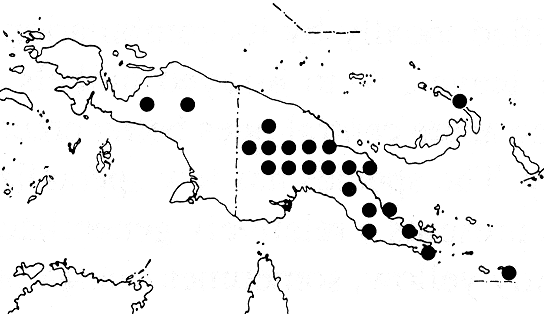
Distribution Map

Description (Barlow 1992)
Loranthus rigidiflorus Krause, Bot. Iahrb. Syst. 57 (v.1922) 465. -Amyema rigidiflora (Krause) Danser, Bull. Jard. Bot. Buitenzorg III, 10 (1929) 298. - Amyema strongylophylla subsp. rigidiflora (Krause) Barlow, Austral. J. Bot. 22 (1974) 594. - Type: Ledermann 9095 (Iecto K, see below), New Guinea, Sepikgebiet, 850 m.
Loranthus barbel/atus Blakely, Proc. Roy. Soc. Qd.
34 (viii. 1922) 27. -Amyema barbellata (Blakely) Danser,
Bull. Jard. Bot. Buitenzorg III, 10 (1929) 294. - Amyema strongylophylla
subsp. barbellata (Blakely) Barlow, Austral. J. Bot.
22 (1974) 594. - Type: White 231 (holo NSW), New Guinea,
Papua, Astrolabe Range, vii-viii. 1918.
For descriptions and additional synonymy see Danser, Bull. Jard. Bot. Buitenzorg III, 10 (1929) 324, 344, under A. barbellata andA. rigidiflora; Barlow, Austtal. J. Bot. 22 (1974) 594, under A. strongylophylla subspp. barbellata and rigidiflora. Amyema rigidiflora can be identified locally by its combination of robust habit, opposite, broadly obovate, petiolate leaves, 7- to 12-rayed umbels of triads, and bracts of the lateral flowers spreading and not more than 2 mm long. The species has few specialized characters and thus presents a relatively generalized facies for the genus. Flower colour is predominantly orange to red, less frequently yellow; often grading to yellow in the upper part.
The species occurs widely in New Guinea, and in Celebes (Talaud
Islands) from sea level to 2150 m elevation (fig. 13; 45 collections
seen). It occurs both in open forests and in rain forests. It
has been recorded several times as parasitic on Castanopsis
and Eucalyptus and has also been recorded on Aglaia,
Macaranga, and Saurauia.
Barlow (1974) treated both A. rigidiflora
and A. barbellata as distinct subspecies of A. strongylophylla,
but commented on their close similarity and on their sharp
differences from the typical subspecies. Study of the materials
now available indicates that A. rigidiflora and A. barbellata
cannot be maintained as distinct, even as subspecies. On the
other hand, the sharp differences from A. strongylophylla are
confirmed, and it is concluded that they are properly treated
as distinct species. For differences, see note under A. strongylophylla.
Amyema rigidiflora is similar, and possibly related, to A.
queenslandica (see note there).
Distribution Map
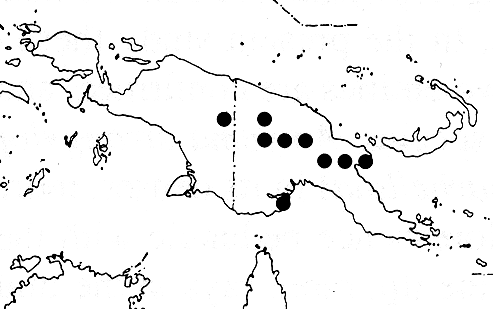
Description (Barlow 1974) of Amyema strongylophyllum (Lauterb.) Dans. Bull. Jard. bot. Buitenz. 10: 299 (1929); 11: 348 (1931); Loranthus strongylophyllus Lauterb. Nov. Gum. 8: 815 (1912). Type-New Guinea, Bivak Hollandia, 30 m alt., GIellerup 307, 18.viii.1910 (B, holotype, not seen, probably destroyed; K; U 32783; WRSL).
Loranthus barbellatus Blakely, Proc. Roy. Soc. Qd. 34: 27 (1922); Amyema barbellata (Blakely) Dans. Bull. Jard. bot. Buitenz. 10: 294 (1929); 11: 324 (1931). Type-Astrolabe Ra., Papua, White 231, July-Aug. 1918 (Nsw).
Loranthus obtusus Krause, Bot. Jahrb. 57: 479, 480 (1922). Type-New Guinea, Finisterre Mts., 1000 m alt., Schlechter 17991, 5.vii.1908 (B, holotype, not seen, probably destroyed; K).
Loranthus rigidflorus Krause, Bot. Jahrb. 57: 465 (1922); Amyema rigidiflora (Krause) Dans. Bull. Jard. bot. Buitenz. 10: 298 (1929); 11: 344, illus. Fig. 12, d-f (1931). Type-New Guinea, Sepikgebiet, 850 m alt., Ledermann 9095 (B, holotype, not seen, probably destroyed; K).
Vegetative parts glabrous; inflorescence and flowers sparsely to densely brown- or red-brown-tomentose or the flowers rarely glabrous. Leaves opposite; petiole winged in the distal part, flat above, 0.5-1 cm long; lamina broadly ovate to orbicular, 4-13 by 3.5-11 cm, dull on both sides, abruptly attenuate at the base, rounded at the apex; venation pennate with the veins usually distinct and the lateral veins arising near the base of the lamina. Inflorescences usually several at the nodes; peduncle robust, 15-30 mm long, (l)1.5-2.5 mm thick, more or less dilated at the apex; rays 7-20, (6)-8-13 mm long; pedicels of the lateral flowers spreading, 2-4 mm long; bract erect or spreading, usually obtuse, flat, 1.5-2 mm long. Calyx cup-shaped; limb erect, 0.5-1 mm long, irregularly split. Corolla in the mature bud acute or obtuse, not clavate, (20)-25-45-(60) mm long; petals in the open flower 5 or 6, with a tuft of deflexed hairs inside at the apex, sometimes with a deflexed spur on the inside at the base. Anthers 3-5 mm long, covered in bud with deciduous appressed hairs, with a knob-like sterile tip; free parts of the filaments 4-6 mm long. Fruit cup-shaped to ellipsoidal, 5-8 mm long, crowned by the persistent calyx limb.
Occurrence. New Guinea, from Wissel Lakes to Rossel I. (Fig. 6), sea level to 2125 in altitude.
The materials examined have been placed in three subspecies with relatively distinct geographical andlor altitudinal ranges. One of these subspecies is rather distinct morphologically, while the other two tend to run into each other.
Key to Subspecies of Amyema strongylophyllum
1. Indumentum of inllorescence dense
(except sometimes for the corolla), red-brown. Leaves relatively
large (cf. species description). Rays 15-20, arising from distinct
depressions in a more or less spherical dilation of the peduncle
apex. Corolla c. 50 mm long 26a. Subsp. strongylophyllum
1. Indumentum of inflorescence
brown or yellow-brown, sparse to dense or absent. Leaves mostly
small. Rays 7-12, arising from shallow depressions in the upper
part of the dilated peduncle
apex. Corolla up to 40 mm long 2
2. Calyx tomentose 26b.
Subsp. rigidiflorum
2. Calyx glabrous 26c. Subsp. barbellatum
26b. Subsp. rigidiflorum (Krause) Barlow, comb. et stat. nov.
Loranthus rigidiflorus Krause, Bot. Jahrb. 57: 465 (1922);
Amyema rigidflora (Krause) Dans.
Loranthus obtusus Krause.
Indumentum of inflorescence brown or yellow-brown, or rarely corolla glabrous. Lamina mostly less than 10 cm long. Inflorescence rays 7-12, arising from shallow depressions in the upper part of the dilated peduncle apex. Corolla in the mature bud usually acute at the apex, up to 40 mm long. Chromosome Number.- n = 9 (Barlow and Wiens 1971). Voucher: Barlow 935, see below.
Occurrence. New Guinea, from Wissel Lakes to Milne Bay (Fig. 6), usually between 1000 and 2125 m altitude, rarely down to 70 m.
Representative Specimens. WEST IRIAN: Doglia, N. of Kebo, Wissel Lakes, Vink and Schram BW 8860, 24.v.1960 (L; CANB). EASTERN NEW GUINEA: Wagau, Herzog Ra., 1540 m alt., Barlow 935, 7.ii.1965 (BRIu; AD; LP LAE); North Sagarai Valley, Milne Bay District, 70 m alt., Henty NGF 16853, 30.v.1964 (LAE; CANB).
26c. Subsp. barbellatum (Blakely) Barlow, comb. et stat. nov.
Loranthus barbellatus Blakely, Proc. Roy. Soc. Qd. 34: 27 (1922); Amyema barbel-lata (Blakely) Dans.
Indumentum of inflorescence sparse; calyx and corolla glabrous. Lamina mostly less than 8 cm long. Inflorescence rays 7-12, arising from shallow depressions in the upper part of the slightly dilated peduncle apex. Corolla in the mature bud usually truncate at the apex, up to 40 mm long. Chromosome Number.- n = 9 (Barlow and Wiens 1971). Voucher: Barlow 973, see below.
Occurrence. Eastern New Guinea, in coastal lowlands from Port Moresby to Rossel I. (Fig. 6), sea level to 620 m altitude.
Representative Specimens. EASTERN NEW GUINEA: Taurama, Port Moresby, Barlow 973, 1 9.ii. 1965 (BlUU; AD; LP LAE); Abaleti, Rossel I., Brass 28319, 10.v.1956 (K; L; LAE).
The difference between subspp. rigidflorum
and barbellatum is very slight, and possibly has little
taxonomic value. Subsp. barbellatum may be a race of subsp.
rigidflorum occurring at lower elevations in the eastern
part of its range. There is no sharp boundary between the two
subspecies, and some specimens from this area are difficult to
place.
Illustrations
Photographs
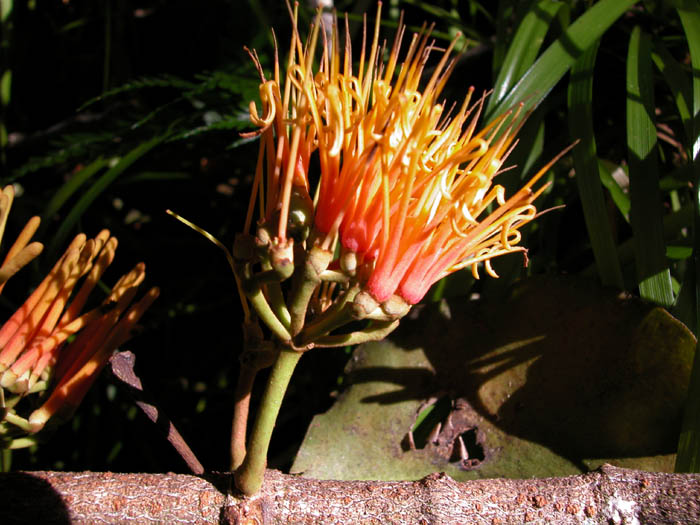
Inflorescence (DLN 4480). W of Wagau Village, Morobe District, Papua New Guinea. 4452 ft (1356 m) elev. Parasitic on Castanopsis. Photo. by D. L. Nickrent.
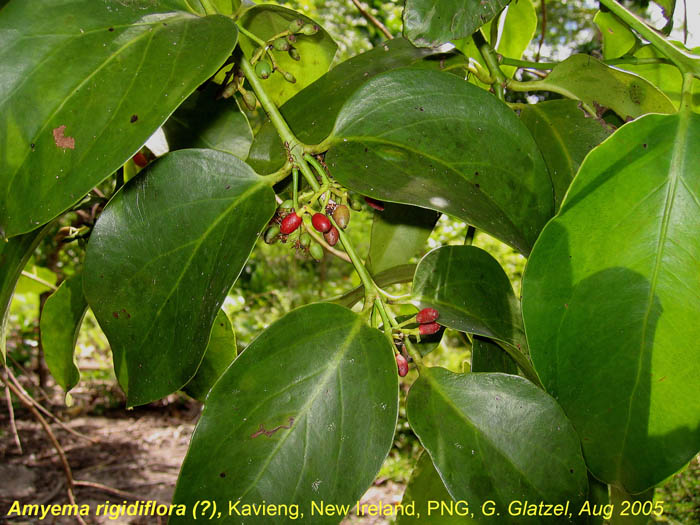
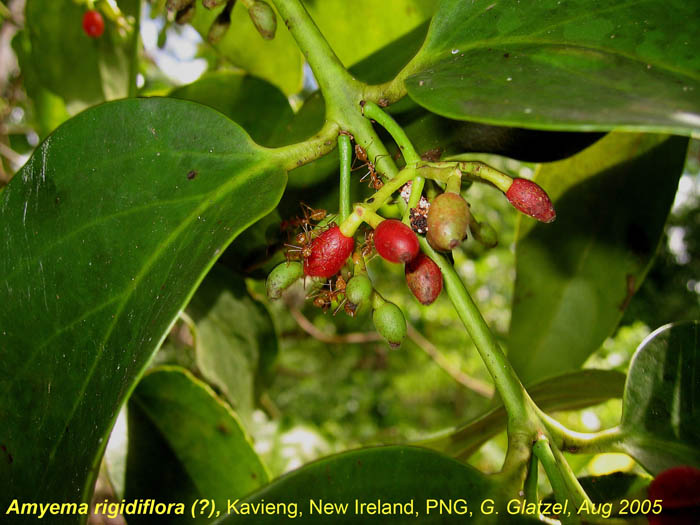
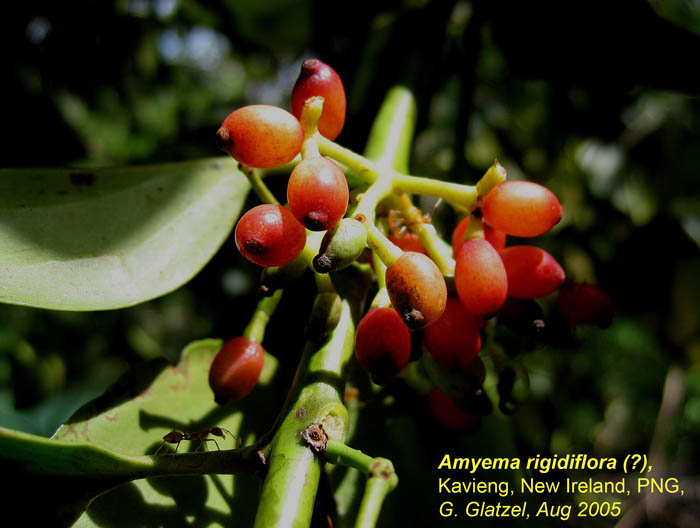
Amyema rigidiflora (possibly). Close-up of fruits. Kavieng, New Ireland, Papua New Guinea. Photo by G. Glatzel August 2005.
Amyema rigidiflorum
updated 22 January 2007